Revising and Feminizing the Fairy Tale in Anastasia
Anastasia, the new musical based on the beloved 1997 animated film, is both decidedly old-fashioned and perfectly suited to the world today.
Many people have developed a constant watchfulness born from distrust and worry. We check social media constantly for news and commentary; we watch the news (and participate in our own fact-checking). But it’s hard to consume that much information and misinformation without developing a nasty side effect: unadulterated cynicism. Read through some replies on Twitter—your own or someone else’s—or the comments on any article, and you’re bound to come across enough mean-spirited, cruel, and ignorant words to make you lose a tiny bit of faith in humanity. Repeat this over and over again, and it’s enough to make anyone feel jaded.
At first glance, it might seem frivolous to produce an opulent historical fairy tale (and a Russian one, at that) in this day and age. We need edgy, modern art, some would argue—art that reflects our world and cautions us of the possible consequences. Less Disney, more Handmaid’s Tale. And we do need that kind of art. But our psyches can’t take a steady diet of dystopia and cautionary tales; we need joy and hope to remind us that there is a great deal of good in the world, too.
Initially, fairy tales … were designed as ‘rough’ entertainment for adults… And more importantly, they served as a controlled, heightened environment in which to explore the world, give warnings, and outline virtues held by a society.
Historically, the fairy tale wasn’t the Disneyfied, cheery comfort food we take it as today. Many have “happy endings,” true, but a darker, more gruesome side as well: the Grimm Cinderella variant involved the stepsisters chopping off parts of their feet to fit into the slipper, while a particular Snow White tale punished the witch by having her dance in hot iron shoes until she died. Initially, fairy tales such as the Grimm brothers’ stories were designed as “rough” entertainment for adults; only later, when youth-oriented tales proved more commercially attractive, did they clean up the stories to remove sexual (though not violent) content. And more importantly, they served as a controlled, heightened environment in which to explore the world, give warnings, and outline virtues held by a society. Scholar Jack Zipes, one of the foremost experts on the Western fairy tale, continually reminds us that these tales “don’t come out of thin air; they are produced at a certain time in history, and they reflect a society’s values and customs and processes.” Such tales are a lens through which we can safely explore both the positive and negative aspects of a culture or a society.
This is the kind of fairy tale we need more than ever, and this is what Anastasia strives to be. It looks at a world fractured into “before” and “after,” and at damaged people whose lives are defined by that dichotomy: orphans, petty criminals, refugees. Anya (a revelatory Christy Altomare) is an amnesiac orphan, found wandering the streets at sixteen, has spent a decade working odd jobs and dealing with fragmented memories and PTSD-like symptoms. Conman Dmitry (Derek Klena, as a deceptively complex character) is an orphan too, the son of an anarchist killed in a labor camp. The Dowager Empress Maria (Mary Beth Peil) transforms from the doting grandmother of the prologue into a cold, bitter woman who dwells on all she has lost. Gone is the animated film’s nightmare-inducing Rasputin (and the unfortunate historical implications his story line had); in his place is Gleb (Ramin Karimloo), a Soviet official climbing in power who can’t escape his father’s violent legacy and isn’t sure if he wants to.
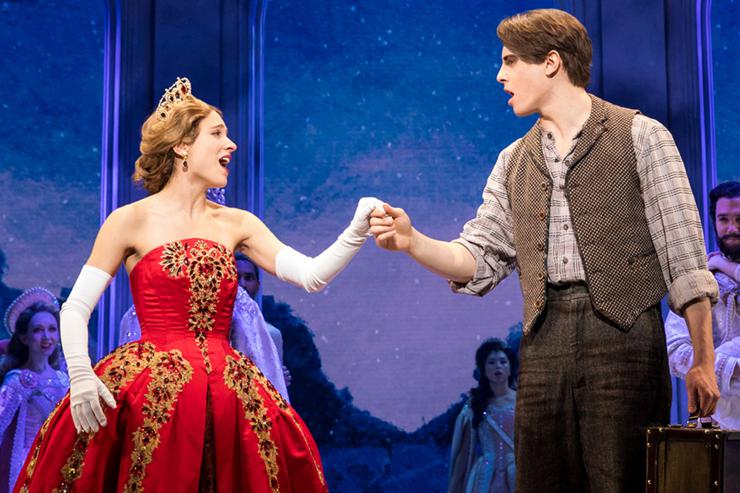
But, like the best kind of fairy tale, Anastasia suggests that it is, in fact, possible to heal. In a 2012 New Yorker article, Joan Acocella comments that the fairy tale can “provide hope: they tell us that we can create a more just world.” The score by Stephen Flaherty and Lynn Ahrens does just that, pulling hope and beauty out of despair, and Terrence McNally’s book—though occasionally leaving a few plot holes or easy resolutions—does the same. You cannot go back, but there is a future beyond the darkness, if good people stand up and refuse to be forced into the past any longer.
Which, interestingly enough, is where Anastasia diverges from its fairy tale predecessors. Traditionally speaking, the fairy tale is a story of restoration. We have “Cinderella,” the noblewoman forced into servitude but who becomes royalty in the end, or “Beauty and the Beast” variants, generally featuring a prince who is cursed but then restored to human form, Sleeping Beauty restored to waking life after being cursed, and so on. The protagonists are knocked down, but their journeys restore them to their perches and the “rightful” order is restored. Anastasia takes the fairy tale format—a virtuous but lost heroine, a journey of discovery, a quest, helper figures, a romance—and modernizes it simply by taking the opposite view. Restoration of the past is not possible or even desirable; Anastasia’s happy ending comes about when characters accept that and forge a new path forward.

Thus, Anastasia isn’t quite a typical “princess story.” Instead, it takes that framework to tell a story about what happens to people whose lives are stripped away by change that does not care to take them into account. Everyone in the story has lost something, from the romantic leads who both lost their parents to the cruelty and intolerance of an oppressive regime, to the exiled emigrants mournfully promising, “I’ll bless my homeland till I die.” A raucous Act 2 number takes place at a Russian émigré club (which really did exist) in Paris. Jazzy and upbeat, it seems to suggest that life in exile isn’t quite so bad—until one realizes that these aristocrats lost everything, and literally all they have now is reminiscences of the “Land of Yesterday.”
The classic fairy tale heroine is more take charge than twentieth-century animation might have you believe. The unnamed heroine of “East of the Sun and West of the Moon,” a “beauty and the beast” variant, conquers what she is told is impossible in order to right past wrongs. Even Cinderella, in some variants, actively participates in her own transformation. It is to this category that “Anya” belongs, and it is the means by which this story fulfills the fairy tale function of defining virtue. Persistent and hopeful even in the face of adversity, Anya’s roots as a 90s-era “modern princess” are visible. However, she’s also a scrappy orphan who fights, and not just figuratively. While her contemporaries from animated fairy tales often put up a token resistance before the hero must step in, Anya holds her own in a street fight, and it is her ferocity, not Dmitry’s, that scares off their attackers. In fact, all three of the central female characters are competent, complex characters (who, not incidentally, also help the show pass the Bechdel Test and a slew of other feminist barometers with flying colors). Two of them have romances, but care is taken to define them apart from those: Anya seeks to understand her identity; Maria fights to live in a world that has taken all she loves; Lily strives to find joy in new circumstances. This is a musical driven by women’s hopes, losses, dreams, and desires—some romantic, but many not.
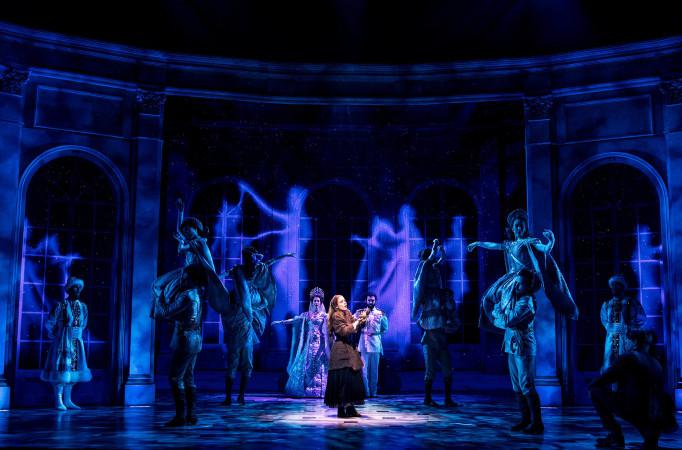
And if fairy tales are a way for us to work through issues of our society, then Anastasia, in its resistance to a particular fairy tale trope, is exactly the tale we need today. The majority of classic fairy tales tend to define heroines by their physical beauty; as Zipes suggests in his book Fairy Tale as Myth, “All girls are supposed to become ‘beauties’; i.e., selfless and nameless.” Furthermore, those beautiful bodies are rarely under their own control and consent—or even their own gazes, as many fairy tales and their descendant tales are filtered through the eyes of the male hero who gazes upon her. Anastasia, on the other hand, is decidedly feminized (and feminist). While Altomare is, of course, lovely, costume designer Linda Cho wisely has Anya spend the entire first act as a scruffy, tomboyish peasant, with simple hair and clothes that denote her lowly status as, essentially, a migrant worker, before donning glittering, glamorous gowns in Act 2 as she embraces her possible royal identity. Her beauty is not the cornerstone of her virtue; that comes from her courage, hope, and defiant persistence.
Additionally, a subtle but running feminist theme is Anya’s control over her own body and physical space. Following the previously mentioned street fight, she brusquely explains to Dmitry that she “learned to take care of herself” while walking alone across Russia—one can extrapolate the various reasons (some gendered, some not) that implies. Even in her romantic arc, in which the classic fairy tale heroine is pursued, not the pursuer, Anya takes the lead. After Dmitry comes to check on her after hearing her scream from a nightmare, she asks him to stay for a little while, and they share an emotionally charged scene while clad only in a nightgown (her) and a tank top and pajamas (him). While G-rated, this scene bends the rigid “purity” taboos that tend to govern both the fairy tale structure and the historical milieu in which this particular story takes place. And Anya does not wait around for her “prince,” angst-ridden over their class differences, to kiss her—she takes charge, climbs up on a suitcase, and kisses him first!
Today’s world needs fairy tales like Anastasia to gently but surely present more balanced ideas about romance and femininity, and to remind children and adults alike that there is more to the world than the bad things we see happening every day.
“The new order has no need for fairy tales,” says Gleb at the end of Anastasia. He could easily be talking about the attitude of our society, concerned with more pressing and contemporary matters. But fairy tales are the means by which generations of children learn about how the world works. Today’s world needs fairy tales like this to gently but surely present more balanced ideas about romance and femininity, and to remind children and adults alike that there is more to the world than the bad things we see happening every day. Experiencing joy cannot stop those things from happening, to be sure, but finding happiness when forces conspire to steal joy is its own act of rebellion.
Oh, and one last note (and a spoiler warning). The show’s happy ending hinges upon a rising member of the government choosing to follow his own moral compass rather than the orders of a cruel and corrupt government. Maybe a fairy tale like Anastasia has more to say about the modern world than it seems…


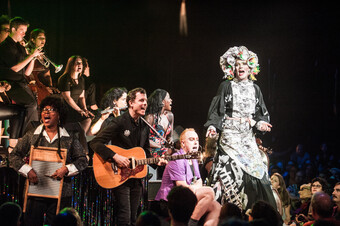

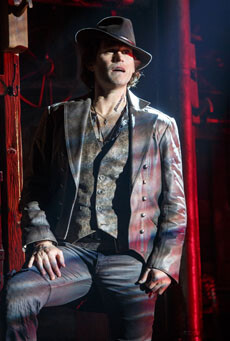

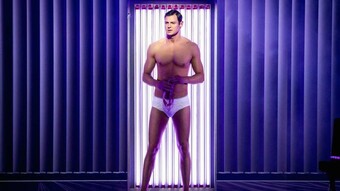

Comments
The article is just the start of the conversation—we want to know what you think about this subject, too! HowlRound is a space for knowledge-sharing, and we welcome spirited, thoughtful, and on-topic dialogue. Find our full comments policy here
What a wonderful piece that expertly expresses what I loved about the show!
Thank you so much for your kind words! It really means a lot to me to see comments on here from people glad to see a perspective beyond the "thumbs up/thumbs down" snark of the "regular" critics. That's one of the things I love about HowlRound - the NewCrit section that this is a part of has a ton of critical pieces that dive beyond just "reviewing" productions and try to place shows in context and deeper meaning.
Anastasia has very quickly become my new favorite show and this is why! Thank you for this article and congrats on how much the Anastasia PR team loved it! :)
Thanks for the lovely comment! I really was surprised and humbled by the amazing response I got from the production and people involved - I think it's a nice reminder that every show, even the ones that don't make headlines or break records, has a lot of people who feel very passionately about it and believe in it wholeheartedly. Theatre is a tough business, but a very beautiful one in that way.
I was nearly in tears on opening night because of how much the critics panned this show that I loved so much in previews and felt such a connection with. This article is so refreshing to read after all that negativity, and expresses exactly why Anastasia is so wonderfully powerful.
I really appreciate your kind comment! I think this was an easy show to dismiss, from a critical perspective - especially given the main demographic. Several reviews seemed to feel the need to point out how many teenage and twentysomething girls were in the audiences, as if that is somehow an indicator of quality. I wanted to suggest an alternate take on the show, one that embraces the perspective of young girls and women, rather than devalues it.
This is a fantastic piece! I loved the show and was surprised to see so many critics panning it. Its nice to read an analysis of it from somebody who is in the show's target demographic.
Thank you so much! There was a really amazing piece here on HowlRound a while back discussing critical bias; I think it actually hit a few days/weeks before my article here was published. While I certainly respect the expertise of professional theatre critics, I feel like there are a couple of issues at hand. One, simply, is that professional criticism makes critics look for things to criticize, rather than praise; it's easy to get cynical when your job requires you to have a snappy, tweetable take on everything. The other, which is what the article I refer to discusses, is the sheer homogeny of the current critical establishment. You're absolutely right that this show is outside the "demographic" of most critics - I firmly believe that a wider diversity of critical voices would produce a fairer and more accurate critical mass.
Good writing here that gives me hope for better theater. And I'm glad this passes the Bechdel test. The characters in this fairy tale are well-rounded, indeed. I have written a play based on the Anastasia legend, although I call it "Natasha". I use the play as a vehicle to defend exploited and destitute children.I am familiar with Russian culture but I also deviate from history, in a good way I hope. I have a Rasputin-like character in my play.
Your play sounds fascinating too! It really is such a rich history to draw from. I think that's what makes this show so special: it blends the fairytale paradigms with the stark realities of the history of the era.
This is a fantastic article, thank you for pinpointing why it's necessary to have art that is not all doom and gloom in our difficult times. Very random question: could you share your source as to the Neva Club having existed for Russian emigres in Paris?
Thank you for the kind words! While I don't know if there was a club actually called the Neva Club, White Russian emigre society was quite the subculture in Paris. This article describes that scene a bit: http://www.pushkinhouse.org...
There is also a book, "Russian Emigres in the Intellectual and Literary Life of Interwar France" by Leonid Livak that discusses the way of life of White Russian emigres and their influence on French culture; most of it can be read on Google Books.
I found this essay to be fascinating, and eye-opening.
At the risk of embodying the uninvited ogre at the princess's party, I'd like to introduce something that, to my surprise, has gone unmentioned here even in passing.. I don't know of any other fairy tale that uses (or more accurately misuses) actual historical events. (That's not rhetorical; I literally don't know of any other fairy tale that borrows from actual history. If you do, I'm all ears.) To my mind, as I wrote in my review, Anastasia winds up promoting nostalgia for the last reign of the Romanovs, those elegantly attired autocrats who sponsored pogroms against the Jews and violently suppressed popular Russian calls for democracy.
I wrote a HowlRound piece splitting last season's shows into basically two categories -- escapist and socially conscious. I understand that there is much to say about the allure, and indeed the importance of escapist fare. (and you are quite eloquent on this score in your essay.) But I"m afraid I can't get much past the disrespect for history that Anastasia exhibits.
Well, the fact that the Romanovs were not the greatest rulers was sort of addressed during Gleb and Anya's final confrontation. If I remember correctly, he said something along the lines of, "The Romanovs were given everything and they gave back nothing." But other than that, yeah, the fact wasn't really addressed.
This was actually one of the elements of the show I found most interesting: they only show the Romanovs in a family context, ignoring the politics. I'm sure it was a decision made because they're the heroine's family and were murdered horrifically, but it's certainly a piece of the history that gets ignored. I do still believe, however, that this piece is socially relevant and socially conscious, for its perspective on progress vs. nostalgia for a not-so-perfect past.
There is a moment, however, that references the Romanov regime's brutality. Dmitry comments to Anya that his father was an anarchist who was taken away to die in a labor camp when he was a young boy. That wouldn't have been the Soviets who did that - it would have been the Romanovs. I think that fact could have been emphasized more to add that layer.
The foil of Gleb looking to accomplish what he's always known to Anya's looking to find what she's never known added a depth to the musical that felt extremely genuine to me.The beauty in Anya finding out who she is through her own journey and who/what matters to her is such a powerful feminist message. Once she knows herself, she stands firm in her decisions and along the way, when completely unsure of her path, she trusts in herself/her dreams. She doesn't discredit her confusion and mindset even though it is difficult and traumatic. Beautifully put article and I hope that the musical gathers more support and attention. it certainly deserves great acclaim for not only the storytelling, but the talent behind the entire production.
This is such a beautiful way to phrase their journeys! And add to that, Dmitry finally knowing something certain after a lifetime of instability, and Maria trying to ignore what she knows deep down (that Anya is Anastasia). Anya is such a remarkable character, for that strength of conviction. That's actually a trait from certain subtypes of fairytale heroine: many are single-minded in pursuit of something they know to be right or true or desirable.
"...we need joy and hope to remind us that there is a great deal of good in the world."
As a huge fan of classic musical theater I agree completely. And I found this article very interesting. But I'm also very confused... I've never seen (or heard) any version of "Anastasia" (I've never give a you-know-what whether somebody is related to so-called royalty or not; that's not now I evaluate people and I have always been a bit dismayed that so many people apparently do), but from the description in this article it sounds like most of the characters are pretty miserable. (At least until the ending, but that [at least to one who is not familiar with the story] sounds like a bit of a Deus ex Machina.)
Is there an easy way to explain why this fairy tale (or at least this production) is so full of joy and hope?
The characters dwell in miserable circumstances, certainly, but they themselves are not miserable, which I think is the key distinction the show makes. I believe the story as a whole is joyful and hopeful because these characters are able to find happiness and a future in spite of those circumstances. (For what it's worth, the ending is less of a deus ex machina and more the endpoint of a sustained character arc). By the end of the story, every character has found peace within themselves and is looking to the future with hope, not cynicism or despair. To me, that is a story that conveys joy and hope.
Great piece! And couldn't agree more. But what does it say about me that my first reaction was: "Wait! There is no Rasputin!? Bullshit!" :)
It says that you're probably a 90s kid like me? :) The story works just as well without him, in my opinion, and it definitely addresses history better than "green demon bats caused the Russian Revolution!"
WAIT-Demon bats weren't the cause of the Russian Revolution?
I am indeed a 90's child! But I am also a feminist art historian: https://venusvocalized.word..., so I should know better haha.
It's worth nothing that some of these differences may be attributed to the fact that ANASTASIA is NOT a Disney vehicle, and never was. Also, it's Terrence.
It definitely helps that the animated film was 20th Century Fox, not Disney, and didn't have to fit into that mold quite as closely. There's a lot of really interesting research on how Walt Disney reinterpreted the fairy tale genre to reflect mid-century American values, and that's evident in many of the Disney films. And yes, of course Terrance McNally is excellent; Ragtime (also with Ahrens/Flaherty!) is one of my favorites!